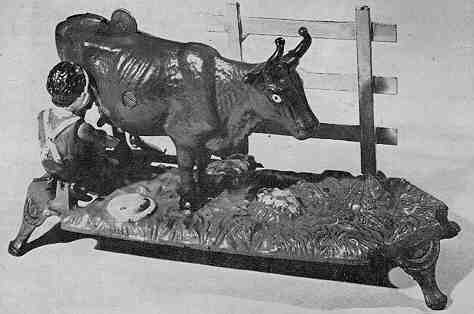Milking Cow Bank
by F.H. Griffith - HOBBIES Magazine - August, 1953

Country and farm scenes in Currier and Ives prints have become quite desirable and valuable over the period of years since their original dates of issue. Perhaps this appeal of country and farm life enters into our choosing the Milking Cow Bank as No. 23 in our numerical listing. This, plus its interesting action, rarity, and the fact that it’s hard to find in original condition with no repairs or replaced parts, ranks it among the top banks.
The Milking Cow Bank is again one which is an unknown quantity as to the actual designer or manufacturer. There are, however, as is the case in a number of the banks, certain clues from the bank itself that indicate a particular designer and manufacturer. The legs supporting the base of the bank are identical to those on the pattern Wishbone Bank and this was definitely designed and made by Charles Bailey. Also, the facial work on the boy milking the cow is indicative of Bailey. Then too, Bailey liked to use flowers on his banks and these are in evidence on the Milking Cow. It is fairly accurate to attribute the bank to Bailey. Since most of his designs were then manufactured as the banks themselves by the J. and E. Stevens Company of Cromwell, Conn., we can be reasonably sure that Stevens made the bank. Its period of manufacture was in the mid 1880’s.
The example pictured is in original condition with fine paint and no repairs or replaced parts. This excellent specimen was finally obtained by the writer after having owned several imperfect Milking Cow Banks in the early period of collecting. It was purchased some years ago from an antique dealer in Cambridge, Mass. When one of the banks turns up the fence is usually missing. This is due to the fact that it is fastened to the base in a very flimsy manner. Also the fence was subject to easy breakage when the bank was handled or played with. Then too the legs on the base were easily broken, and since the base itself is a rather thin casting it cracked readily. In later models the base casting was made heavier to strengthen the bank and overcome its tendency to crack.
The operation of the bank starts with its component parts in the positions shown in the picture. A coin is placed in the slot in the cow’s back, then the large flower-shaped lever in front of the cow is pushed. This causes the cow to flip its tail in the air and kick its right hind leg. In so doing she tips the boy over backward and the milk pail held in the boy’s movable arms is dumped into his face. At the same time the coin drops into the cow. The flower is released, the boy set in position, and the bank is again ready to operate.
The bank is painted in attractive, appropriate colors. The base is green with some white daisies and the large flower lever is red. The legs of the base are gold and the fence white. The cow is reddish brown, such as a Jersey, with gold tipped horns. The boy has a red shirt and blue trousers and his yellow hat lies beside him.
The method of removing the coins from the Milking Cow Bank is of interest as it is necessary to remove the cow from the base and then take the cow apart. Frankly speaking it is poorly designed from the standpoint of being strictly a savings bank. Of course the mechanical banks were primarily designed to amuse and entertain, to encourage saving and this bank certainly does that. However, it can well be imagined that many of these banks were broken trying to remove the coins, and on occasion intentionally dropped and broken to get them out. These points naturally contribute to its rarity today.
To sum it all up, the Milking Cow Bank is a nostalgic desirable item to have in a collection and offers a challenge to find in original condition throughout.
